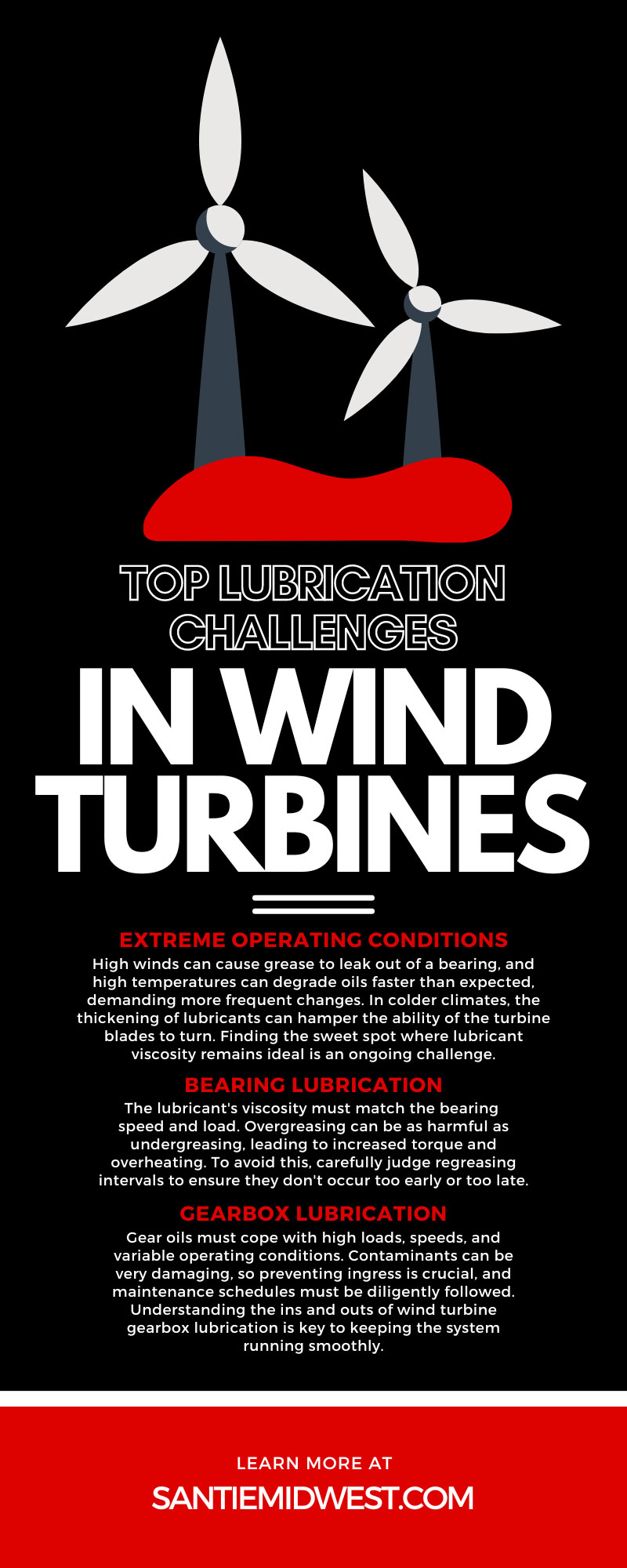Wind turbines are the backbone of the modern renewable energy sector. Each turbine, whether a solitary sentinel in the countryside or a part of a vast offshore farm, helps drive sustainability and innovation. To turn the fleeting power of the wind into a stable source of electricity, these structures rely on a labyrinth of mechanical systems—and at the heart of these systems is good lubrication management.
Lubrication in wind turbines is critical for reducing friction, heat, and wear between moving parts, allowing the turbine to operate with optimal efficiency. However, the unique environmental conditions and colossal scale of these turbines present a host of challenges that manufacturers, maintenance teams, and engineers must continually address. These are the 10 top lubrication challenges in wind turbines to watch out for. Ensure your investment lasts as long as possible.
Importance of Lubrication in Wind Turbines
For wind turbines, the cost of failure is high—both economically and environmentally. Effective and timely lubrication is vital to the industry, as it:
- Minimizes downtime and maintenance costs
- Maximizes power generation for better return on investment
- Contributes to the safety and longevity of the equipment
Lubrication technology is evolving, as are the demands placed on wind turbine machinery. Understanding these challenges equips professionals to make informed decisions that ensure the smooth operation of these green energy beacons.
Challenge 1: Extreme Operating Conditions
Wind turbines operate in some of the most inhospitable environments on the planet. The lubrication challenges here are not just about choosing the right grease for the mechanism but about understanding how temperature, humidity, and wind speed alter the lubrication properties.
High winds can cause grease to leak out of a bearing, and high temperatures can degrade oils faster than expected, demanding more frequent changes. In colder climates, the thickening of lubricants can hamper the ability of the turbine blades to turn. Finding the sweet spot where lubricant viscosity remains ideal is an ongoing challenge.
Challenge 2: Bearing Lubrication
Bearings are the workhorses of wind turbines, supporting the weight and ensuring the proper alignment of rotating components. Lubrication failures can lead to catastrophic bearing damage, so selecting and applying the right lubricants here is paramount.
The lubricant's viscosity must match the bearing speed and load. Overgreasing can be as harmful as undergreasing, leading to increased torque and overheating. To avoid this, carefully judge regreasing intervals to ensure they don't occur too early or too late.
Challenge 3: Gearbox Lubrication
The gearbox in a wind turbine is akin to a car's transmission, converting the blades' low-speed rotation into high-speed motion for the generator. This component is a labyrinth of gears and bearings, and the challenges in lubricating it are multifaceted.
Gear oils must cope with high loads, speeds, and variable operating conditions. Contaminants can be very damaging, so preventing ingress is crucial, and maintenance schedules must be diligently followed. Understanding the ins and outs of wind turbine gearbox lubrication is key to keeping the system running smoothly.
Challenge 4: Pitch and Yaw Systems
The pitch and yaw mechanisms are essential for controlling the orientation and blades of the turbine, optimizing the capture of wind energy. Lubrication considerations for these systems differ greatly from those for bearings and gearboxes.
The frequency of movement, potential for contamination, and accessibility all play into the lubrication strategy for pitch and yaw systems. The challenge here is providing enough lubricant to keep these systems moving freely without attracting too much dirt or causing excess wear.
Challenge 5: Main Shaft Lubrication
The main shaft is the backbone of the wind turbine, transferring the gearbox's output to the generator. Maintaining the integrity and functionality of the main shaft's bearings is critical for overall turbine operation.
Lubricant selection for main shaft bearings is a balancing act, needing to withstand heavy loads while offering adequate anti-wear protection during operation.
Challenge 6: Generator Lubrication
The generator in a wind turbine operates differently from other components, with its own lubrication needs. You must carefully monitor its lubrication system to ensure it adequately protects the interior components from the high electrical and mechanical stresses they endure.
Choosing a lubricant for a wind turbine generator involves considering factors such as electrical conductivity, thermal stability, and the ability to resist the high forces within the operational confines of the turbine. The properties of the lubricant are a key consideration here, as well as its ability to manage high peak loads and maintain its performance over time.
Challenge 7: Hydraulic System Lubrication
Hydraulic systems within wind turbines are crucial for controlling the movement and operation of various components. The lubricants used in hydraulic systems must be compatible with seals and materials in the system, and the hydraulic fluids should offer excellent temperature and viscosity stability under the extreme conditions experienced by wind turbines.
Maintaining clean hydraulic fluid is essential, as contaminants can cause malfunctions or damage the system over time. Implementing contamination control measures, such as proper filtration and regular fluid analysis, is essential to prolong the service life of the hydraulic components and reduce turbine downtime.
Challenge 8: Preventing Contamination
Preventing contamination of lubricants is a significant challenge, as any debris or foreign material can lead to increased wear, reduced performance, and costly repairs.
Strategies to combat contamination include utilizing advanced sealing technologies, implementing stringent filtration systems, and performing all maintenance and regreasing procedures in controlled environments.
Challenge 9: Lubrication System Monitoring
The need for proactive rather than reactive maintenance is apparent in large-scale machinery like wind turbines. Regular inspections and oil analysis are indispensable tools for monitoring the condition of lubricants and identifying potential issues before they escalate.
Oil analysis can reveal the presence of wear particles, signs of thermal degradation, or fluid contamination, allowing for informed decisions on maintenance and lubricant renewal.
Challenge 10: Maintenance and Training
A well-educated and well-equipped maintenance team is essential for addressing the complex lubrication challenges in wind turbines. It is not just about knowing when to apply grease or change oil but understanding the specifics of wind turbine lubrication and how to adapt to evolving lubricants and machinery.
Creating a comprehensive maintenance plan that integrates the latest lubrication strategies and providing ongoing training for technicians will help ensure the continued success of wind energy projects.
Building Reliable Energy Solutions for the Future
Lubrication is, and will continue to be, an integral part of the wind energy sector. As the industry grows, the top lubrication challenges wind turbines face will keep evolving and growing more complex. Addressing these challenges head-on will lead to improved turbine performance, reduced operational costs, and a safer, more reliable energy solution for our future.


